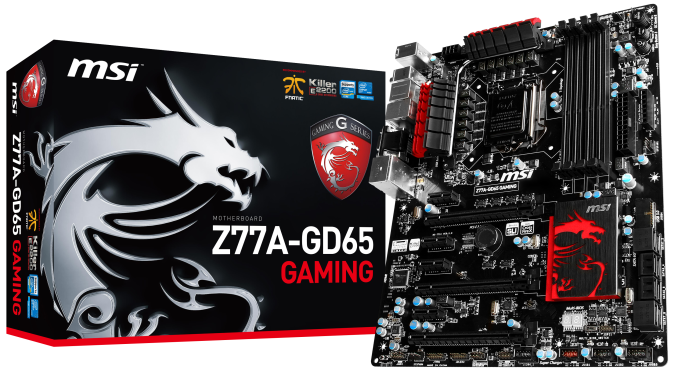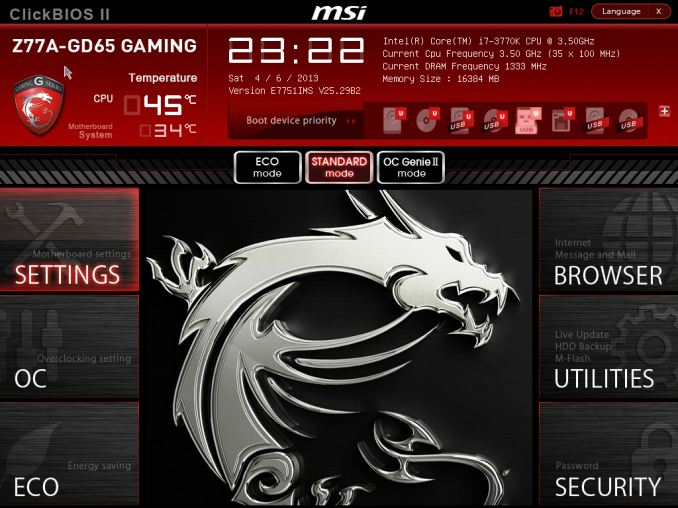MSI Z77A-GD65 Gaming Review
by Ian Cutress on April 18, 2013 12:00 PM EST- Posted in
- Motherboards
- MSI
- Z77
When a product on the market promotes itself as a gaming tool, it cannot just be part of the name or the branding. The product has to showcase why it is a gaming product, and why it is so deserving of our money above and beyond the standard product grade. Associating the product with professional gamers and marketing strongly are worth nothing if the product itself is a poor shell of what is actually good for gamers. Out with the fluff, in with what the real world needs and wants.
It is hard to judge where the MSI Z77A-GD65 Gaming sits on this proverbial spectrum – in almost every way it is the standard Z77A-GD65. What makes it different is the Killer NIC for reduced lag, the gaming port (that has no associated software to make sure it is enabled), and the dragon styling, covering the shape of the VRM heatsink, the chipset heatsink, the BIOS and various elements of the software stack.
The price for all this benefit over the standard model is $15-$30 (when the GD65 is on sale), which is excruciatingly high considering the standard GD65 can be had at common retailers for only $150. For that extra I would want some extra box bonuses, or additional USB 3.0 controllers, or dual NICs, or WiFi, or anything!
Despite all this, the Gaming variant does a better than average job in our benchmark suite. While it seems very power efficient at idle, it starts to approach the higher end when going all out in our gaming suite; performance is better than average, but nothing spectacular especially if a user plans to overclock. The main plus in MSI’s arsenal is Live Update 5, which is great from the ‘keeping up-to-date’ point of view – but all MSI motherboards have this.
The overclocking options, while numerate, are awkward to work with due to any sense of order. I am a big fan of having an easy one button overclock, but the option of an array of one-button overclock modes should the user want to go further. An auto overclock to 4.2 GHz is rather poor given that almost every 3770K sample should hit 4.4 GHz. Why not have two or three options for those that have compatible processors?
Ultimately the Z77A-GD65 Gaming feels a little rushed and out of place, firstly because MSI was planning to release their first gaming boards with Haswell until the Haswell delay, but also because the Z77A-GD65 exists and offers mostly the same functionality for $15-30 less.
Our best ATX board at $180 has been the Gigabyte Z77X-UD5H (bronze award), which features 10 USB 3.0 ports, an mSATA, dual NIC (Intel+Realtek), an included USB 3.0 bracket, and software that offers more auto-overclock options. Is it worth missing on that for dragon styling and a gaming NIC?












37 Comments
View All Comments
hansmuff - Friday, April 19, 2013 - link
Good comment on the polling rate, marketing at its best. I do notice a difference between a 125 Hz rate and a 250 Hz rate in terms of smoothness of the desktop cursor when you move it, but any higher and I personally can't make out a difference.It should also be noted that polling with a higher frequency uses additional CPU cycles, since as the name implies USB is a polling interface.
sherlockwing - Thursday, April 18, 2013 - link
My favorite part of the MSI Z77 board is the 90 degree USB3.0 header, it really helps hiding that huge usb3.0 header.boogerlad - Thursday, April 18, 2013 - link
Is this motherboard a joke? Covering the fins is very stupid, and fins that are shaped merely for aesthetics is even worse. Are aesthetics more important than performance and practicality these days?mwildtech - Thursday, April 18, 2013 - link
Bitch Bitch Bitch - Beat it!HisDivineOrder - Thursday, April 18, 2013 - link
Dare you deny the dragon?Crono - Thursday, April 18, 2013 - link
I dare not. I actually was planning on doing a custom paint case, red and black, with the Dragon Army emblem from the new Ender's Game coming out in fall. The motherboard would fit well, though really even with a side panel no one looks that closely to see some of the theme details on a motherboard."Your ass is dragon!"
Sunstorm - Thursday, April 18, 2013 - link
Hi Ian, I wanted to point out a piece of misinformation that MSI seem to be allowing various review sites to propagate. The board is not capable of 2X SLI (yes, standard two way) when the third PCI-E 3 slot is in use. I was told by MSI tech support that this is due to how the pcie lanes are provided for the third slot, which differs from the majority of other Z77 boards. This occurs even if the third slot is used for a soundcard ie you are not trying to do tri-SLI, SLI is simply disabled.Multiple reviews of the GD65 (and therefore presumably this gamer version) do not highlight this issue and presumably review sites aren't testing this. MSI seems content to allow this misinformation to be spread far and wide, which led to me buying the GD65 and finding it was not adequate for my needs several months after purchase. Thankfully the retailer accepted a return.
Please update the review to reflect this, if reviewers are able to test this and publish it then maybe a few people will avoid the hassle I had
IanCutress - Friday, April 19, 2013 - link
Hi SunStorm,I am communicating with MSI directly on this to see what is up. Personally I feel there may be something wrong with the SLI certification flag. It probably confirms that the x8/x8 arrangement is SLI capable, but the x4 from the chipset is not, but there may be a bug that states if the x4 is populated, disable SLI completely. I am hoping to get a straight answer for you.
Please note I would have tested it if I had access to three of the same NVIDIA GPU, but alas I do not :(
IanCutress - Friday, April 19, 2013 - link
Hi SunStorm. I got an answer, and it boils down to this."In order to run SLI you need either a x16 slot running at @16 or @x8."
So when the third slot is populated, it brings all slots down to x8/x4/x4. Because the second slot is x4, it fails SLI certification.
If you have examples of SLI working in x4 mode *anywhere*, please email me (ian@anandtech.com) as this is rather interesting. If this is truly the case, it's an NVIDIA restriction, not an MSI one.
Ideally if you want 2xSLI and an x4 sound card/RAID card, you need a board that does x8/x8 on PCIe slots and then takes the final x4 from the chipset, such as the Z77 OC Formula or Z77 Extreme6.
Ian
Sunstorm - Friday, April 19, 2013 - link
Thank you Ian, the fact that you took the time to take a look in to this is much appreciated. I have only found one forum post anywhere which highlighted this issue.Since most reviewers are stating that the MSI GD65 (and presumably related boards) is capable of tri-SLI I would imagine other people buying these boards may end up bitten down the line, even if they do their research by looking at reviews. I think in most people's case, given the price level, the fact that it is not tri-SLI capable is not a concern; however, the fact that ANY card in the third slot disables SLI is pretty important for people to be aware of, particularly as it is a behaviour not seen on most Z77 boards. As far as I am aware, the majority of Z77 boards take the lanes for the third slot from the chipset (as you describe), I've now switched to an ASUS v-pro for this reason.
The only instances where I recall I may have seen SLI operating at 4x or lower are the tests of the impact of PCI-E bandwidth on graphics card performance. I'm not sure how those are conducted though.